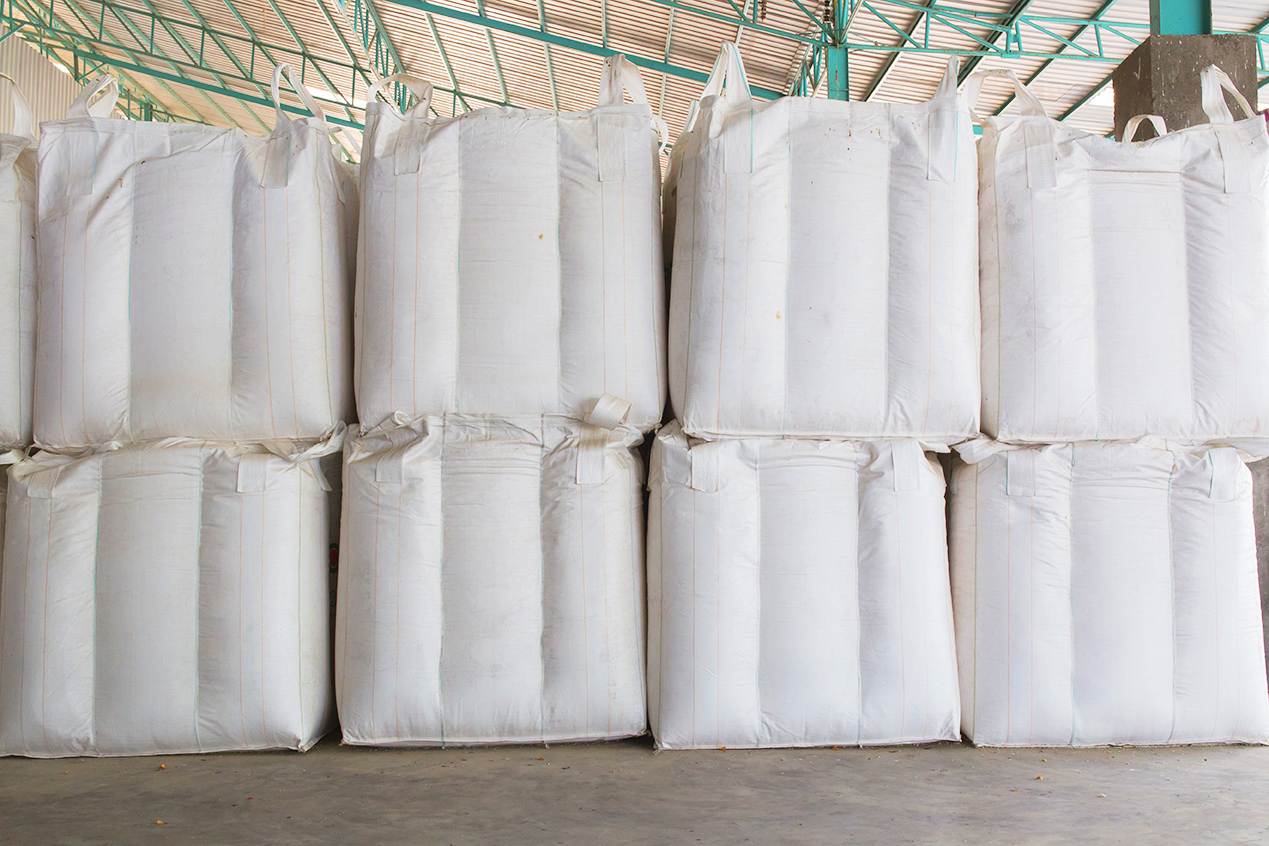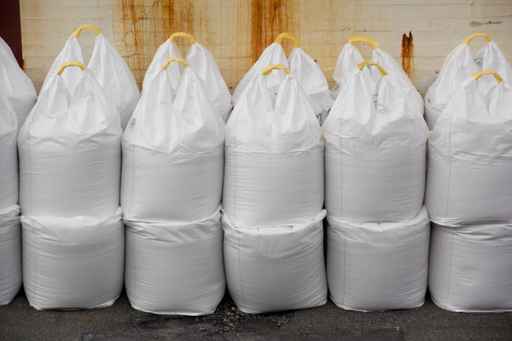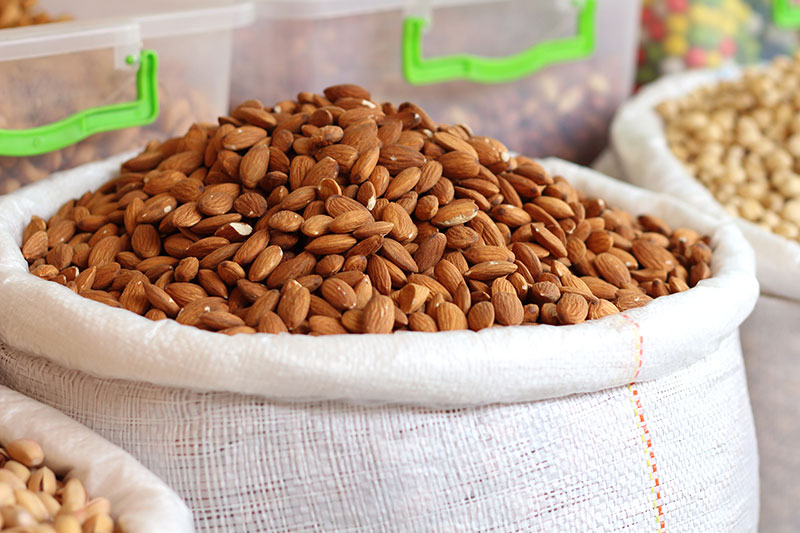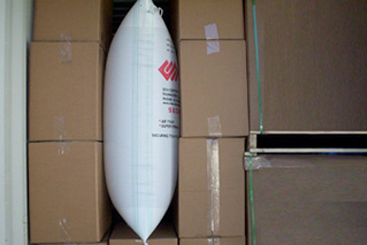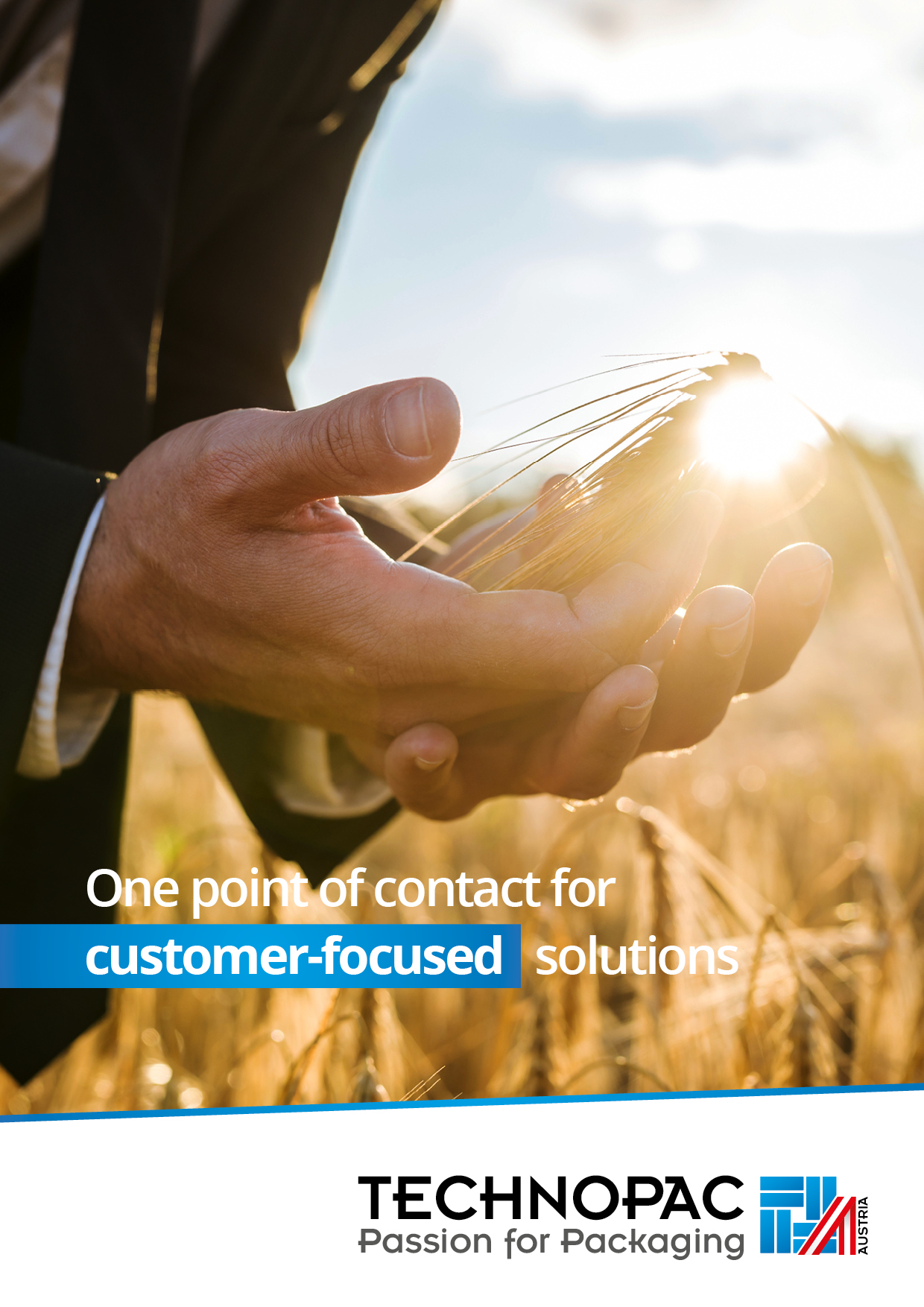Liner for Big bags and octabins
Some bulk materials may cause build up of static energy during the filling and emptying process which can, in the bag itself or on its surface, cause an electrostatic discharge. If explosive dusts or gases are present in the vicinity during the filling or emptying process, there is a fire or explosion risk.
To avoid this risk, a grounded FIBC (big bag) is an ideal solution. Grounded FIBC’s (big bags) are classified as Type C bags. To provide conductivity in these bags, typically carbon filaments are woven into the fabric. In food related applications, silver yarns are used as a replacement for carbon yarns to provide the necessary conductivity properties.
The fabric structure of FIBC’s (big bags) consists either of flat or tubular (circular) form, coated or uncoated. To provide additional protection, design variants with conductive liners are available. Type C FIBC (big bags) need to be grounded during the filling and emptying process. Each grounded bag is conductivity tested for 100% conformity.






Technopac offers a wide range of liners in all required sizes and thicknesses.
The liners protects contents from dust, moisture, oxygen and aroma loss.
Aluminum composite liners are suitable for use in the food industry.
Typical barrier liners are:
-
 PE-LD (LDPE, PEw)
PE-LD (LDPE, PEw)Low-density polyethylene (LDPE) is a thermoplastic made from the monomer ethylene. It was the first grade of polyethylene, produced in 1933 by Imperial Chemical Industries (ICI) using a high pressure process via free radical polymerization. Its manufacture employs the same method today. The EPA estimates 5.7% of LDPE (recycling number 4) is recycled. Despite competition from more modern polymers, LDPE continues to be an important plastic grade. In 2013 the worldwide LDPE market reached a volume of about US$33 billion.
Properties
LDPE is defined by a density range of 0.910–0.940 g/cm3. It is not reactive at room temperatures, except by strong oxidizing agents, and some solvents cause swelling. It can withstand temperatures of 80 °C continuously and 95 °C for a short time. Made in translucent or opaque variations, it is quite flexible, and tough but breakable.
LDPE has more branching (on about 2% of the carbon atoms) than HDPE, so its intermolecular forces (instantaneous-dipole induced-dipole attraction) are weaker, its tensile strength is lower, and its resilience is higher. Also, since its molecules are less tightly packed and less crystalline because of the side branches, its density is lower. LDPE contains the chemical elements carbon and hydrogen.
Chemical resistance
- Excellent resistance (no attack / no chemical reaction) to dilute and concentrated acids, alcohols, bases and esters
- Good resistance (minor attack / very low chemical reactivity) to aldehydes, ketones and vegetable oils
- Limited resistance (moderate attack / significant chemical reaction, suitable for short-term use only) to aliphatic and aromatic hydrocarbons, mineral oils, and oxidizing agents
- Poor resistance, and not recommended for use with halogenated hydrocarbons.
Applications
LDPE is widely used for manufacturing various containers, dispensing bottles, wash bottles, tubing, plastic bags for computer components, and various molded laboratory equipment. Its most common use is in plastic bags. Other products made from it include:
- Trays and general purpose containers
- Corrosion-resistant work surfaces
- Parts that need to be weldable and machinable
- Parts that require flexibility, for which it serves very well
- Very soft and pliable parts such as snap-on lids
- Six pack rings
- Juice and milk cartons are made of liquid packaging board, a laminate of paperboard and LDPE (as the waterproof inner and outer layer), and often with of a layer of aluminum foil (thus becoming aseptic packaging).[5][6]
- Packaging for computer hardware, such as hard disk drives, screen cards, and optical disc drives
- Playground slides
- Plastic wraps
Quelle: wikipedia.org
-
 PE-HD (HDPE)
PE-HD (HDPE)High-density polyethylene (HDPE) or polyethylene high-density (PEHD) is a polyethylene thermoplastic made from petroleum. It is sometimes called "alkathene" or "polythene" when used for pipes. With a high strength-to-density ratio, HDPE is used in the production of plastic bottles, corrosion-resistant piping, geomembranes, and plastic lumber. HDPE is commonly recycled, and has the number "2" as its resin identification code (formerly known as recycling symbol).
In 2007, the global HDPE market reached a volume of more than 30 million tons.
Properties
HDPE is known for its large strength-to-density ratio. The density of HDPE can range from 0.93 to 0.97 g/cm3 or 970 kg/m3. Although the density of HDPE is only marginally higher than that of low-density polyethylene, HDPE has little branching, giving it stronger intermolecular forces and tensile strength than LDPE. The difference in strength exceeds the difference in density, giving HDPE a higher specific strength. It is also harder and more opaque and can withstand somewhat higher temperatures (120 °C/ 248 °F for short periods, 110 °C /230 °F continuously). High-density polyethylene, unlike polypropylene, cannot withstand normally required autoclaving conditions. The lack of branching is ensured by an appropriate choice of catalyst (e.g., Ziegler-Natta catalysts) and reaction conditions.
Applications
HDPE is resistant to many different solvents and has a wide variety of applications:
- Swimming pool installation
- 3-D printer filament
- Arena Board (puck board)
- Backpacking frames
- Ballistic plates
- Banners
- Bottle caps
- Chemical-resistant piping
- Coax cable inner insulator
- Food storage containers
- Fuel tanks for vehicles
- Corrosion protection for steel pipelines
- Electrical and plumbing boxes
- Far-IR lenses
- Folding chairs and tables
- Geomembrane for hydraulic applications (such as canals and bank reinforcements) and chemical containment
- Geothermal heat transfer piping systems
- Heat-resistant firework mortars
- Hard hats
- Hula hoops
- Last for shoes
- Natural gas distribution pipe systems
- Fireworks
- Plastic bags
- Plastic bottles suitable both for recycling (such as milk jugs) or re-use
- Plastic lumber
- Plastic surgery (skeletal and facial reconstruction)
- Root barrier
- Snowboard rails and boxes
- Stone paper
- Storage sheds
- Telecom ducts
- Tyvek
- Water pipes for domestic water supply and agricultural processes
- Wood plastic composites (utilizing recycled polymers)
HDPE is also used for cell liners in subtitle D sanitary landfills, wherein large sheets of HDPE are either extrusion or wedge welded to form a homogeneous chemical-resistant barrier, with the intention of preventing the pollution of soil and groundwater by the liquid constituents of solid waste.
HDPE is preferred by the pyrotechnics trade for mortars over steel or PVC tubes, being more durable and safer. HDPE tends to rip or tear in a malfunction instead of shattering and becoming shrapnel like the other materials.
Milk jugs and other hollow goods manufactured through blow molding are the most important application area for HDPE, accounting for one-third of worldwide production, or more than 8 million tons. In addition to being recycled using conventional processes, HDPE can also be processed by recyclebots into filament for 3-D printers via distributed recycling. There is some evidence that this form of recycling is less energy intensive than conventional recycling, which can involve a large embodied energy for transportation.
Above all, China, where beverage bottles made from HDPE were first imported in 2005, is a growing market for rigid HDPE packaging, as a result of its improving standard of living. In India and other highly populated, emerging nations, infrastructure expansion includes the deployment of pipes and cable insulation made from HDPE. The material has benefited from discussions about possible health and environmental problems caused by PVC and Polycarbonate associated Bisphenol A, as well as its advantages over glass, metal, and cardboard.
Quelle: wikipedia.org
-
 Polyethylene terephthalate (PET)
Polyethylene terephthalate (PET)Polyethylene terephthalate (sometimes written poly(ethylene terephthalate)), commonly abbreviated PET, PETE, or the obsolete PETP or PET-P, is the most common thermoplastic polymer resin of the polyester family and is used in fibers for clothing, containers for liquids and foods, thermoforming for manufacturing, and in combination with glass fiber for engineering resins.
Uses
Because PET is an excellent water and moisture barrier material, plastic bottles made from PET are widely used for soft drinks (see carbonation). For certain specialty bottles, such as those designated for beer containment, PET sandwiches an additional polyvinyl alcohol (PVOH) layer to further reduce its oxygen permeability.
Biaxially oriented PET film (often known by one of its trade names, "Mylar") can be aluminized by evaporating a thin film of metal onto it to reduce its permeability, and to make it reflective and opaque (MPET). These properties are useful in many applications, including flexible food packaging and thermal insulation. See: "space blankets". Because of its high mechanical strength, PET film is often used in tape applications, such as the carrier for magnetic tape or backing for pressure-sensitive adhesive tapes. It is used to make the fabric polar fleece.
Non-oriented PET sheet can be thermoformed to make packaging trays and blister packs. If crystallizable PET is used, the trays can be used for frozen dinners, since they withstand both freezing and oven baking temperatures. As opposed to amorphous PET, which is transparent, crystallizable PET or CPET tends to be black in colour.
When filled with glass particles or fibres, it becomes significantly stiffer and more durable.
PET is also used as substrate in thin film and solar cell.
Physical Properties
PET in its natural state is a colorless, semi-crystalline resin. Based on how it is processed, PET can be semi-rigid to rigid, and it is very lightweight. It makes a good gas and fair moisture barrier, as well as a good barrier to alcohol (requires additional "barrier" treatment) and solvents. It is strong and impact-resistant. PET becomes white when exposed to chloroform and also certain other chemicals such as toluene.
About 60% crystallization is the upper limit for commercial products, with the exception of polyester fibers. Clear products can be produced by rapidly cooling molten polymer below Tg glass transition temperature to form an amorphous solid. Like glass, amorphous PET forms when its molecules are not given enough time to arrange themselves in an orderly, crystalline fashion as the melt is cooled. At room temperature the molecules are frozen in place, but, if enough heat energy is put back into them by heating above Tg, they begin to move again, allowing crystals to nucleate and grow. This procedure is known as solid-state crystallization.
When allowed to cool slowly, the molten polymer forms a more crystalline material. This material has spherulites containing many small crystallites when crystallized from an amorphous solid, rather than forming one large single crystal. Light tends to scatter as it crosses the boundaries between crystallites and the amorphous regions between them. This scattering means that crystalline PET is opaque and white in most cases. Fiber drawing is among the few industrial processes that produce a nearly single-crystal product.
Quelle: wikipedia.org
-
Ethylene vinyl alkohol (EVOH)
Ethylene vinyl alcohol (EVOH) is a formal copolymer of ethylene and vinyl alcohol. Because the latter monomer mainly exists as its tautomer acetaldehyde, the copolymer is prepared by polymerization of ethylene and vinyl acetate to give the ethylene vinyl acetate (EVA) copolymer followed by hydrolysis. EVOH copolymer is defined by the mole % ethylene content: lower ethylene content grades have higher barrier properties; higher ethylene content grades have lower temperatures for extrusion.
The plastic resin is commonly used as an oxygen barrier in food packaging. It is better than other plastics at keeping air out and flavors in, is highly transparent, weather resistant, oil and solvent resistant, flexible, moldable, recyclable, and even printable. Its drawback is that it is difficult to make and therefore more expensive than other food packaging. Instead of making an entire package out of EVOH, manufacturers keep costs down by coextruding or laminating it as a thin layer between cardboard, foil, or other plastics.
It is also used as a hydrocarbon barrier in plastic fuel tanks and pipes.
Quelle: wikipedia.org
-
 Polyamide (PA)
Polyamide (PA)A polyamide is a macromolecule with repeating units linked by amide bonds. Polyamides occur both naturally and artificially. Examples of naturally occurring polyamides are proteins, such as wool and silk. Artificially made polyamides can be made through step-growth polymerization or solid-phase synthesis yielding materials such as nylons, aramids, and sodium poly(aspartate). Synthetic polyamides are commonly used in textiles, automotive applications, carpets and sportswear due to their high durability and strength. The transportation industry is the major consumer, accounting for 35% of polyamide (PA) consumption.
Quelle: wikipedia.org
-
 Aluminium
AluminiumAluminium (or aluminum; see spelling differences) is a chemical element in the boron group with symbol Al and atomic number 13. It is a silvery white, soft, nonmagnetic, ductile metal. Aluminium is the third most abundant element (after oxygen and silicon), and the most abundant metal in the Earth's crust. It makes up about 8% by weight of the Earth's solid surface. Aluminium metal is so chemically reactive that native specimens are rare and limited to extreme reducing environments. Instead, it is found combined in over 270 different minerals. The chief ore of aluminium is bauxite.
Aluminium is remarkable for the metal's low density and for its ability to resist corrosion due to the phenomenon of passivation. Structural components made from aluminium and its alloys are vital to the aerospace industry and are important in other areas of transportation and structural materials. The most useful compounds of aluminium, at least on a weight basis, are the oxides and sulfates.
Despite its prevalence in the environment, no known form of life uses aluminium salts metabolically. In keeping with its pervasiveness, aluminium is well tolerated by plants and animals. Owing to their prevalence, potential beneficial (or otherwise) biological roles of aluminium compounds are of continuing interest.
General use
Aluminium is the most widely used non-ferrous metal. Global production of aluminium in 2005 was 31.9 million tonnes. It exceeded that of any other metal except iron (837.5 million tonnes). Forecast for 2012 is 42–45 million tonnes, driven by rising Chinese output.
Aluminium is almost always alloyed, which markedly improves its mechanical properties, especially when tempered. For example, the common aluminium foils and beverage cans are alloys of 92% to 99% aluminium. The main alloying agents are copper, zinc, magnesium, manganese, and silicon (e.g., duralumin) and the levels of these other metals are in the range of a few percent by weight.
Some of the many uses for aluminium metal are in:
- Transportation (automobiles, aircraft, trucks, railway cars, marine vessels, bicycles, etc.) as sheet, tube, castings, etc.
- Packaging (cans, foil, frame of etc.)
- Construction (windows, doors, siding, building wire, etc.).
- A wide range of household items, from cooking utensils to baseball bats, watches.
- Street lighting poles, sailing ship masts, walking poles, etc.
- Outer shells of consumer electronics, also cases for equipment e.g. photographic equipment, MacBook Pro's casing
- Electrical transmission lines for power distribution
- MKM steel and Alnico magnets
- Super purity aluminium (SPA, 99.980% to 99.999% Al), used in electronics and CDs, and also in wires/cabling.
- Heat sinks for electronic appliances such as transistors and CPUs.
- Substrate material of metal-core copper clad laminates used in high brightness LED lighting.
- Powdered aluminium is used in paint, and in pyrotechnics such as solid rocket fuels and thermite.
- Aluminium reacts with hydrochloric acid or with sodium hydroxide to produce hydrogen gas.
- Aluminium is used to make food containers, because of its resistance to corrosion.
- Aluminium with magnesium [alloy] is used to make body of aircraft.
- Aluminium with other metals, used to make railway tracks.[citation needed]
- Aluminium is used to make cooking utensils, because it is resistant to corrosion, and light-weight.
- A variety of countries, including France, Italy, Poland, Finland, Romania, Israel, and the former Yugoslavia, have issued coins struck in aluminium or aluminium-copper alloys.
- Some guitar models sport aluminium diamond plates on the surface of the instruments, usually either chrome or black. Kramer Guitars and Travis Bean are both known for having produced guitars with necks made of aluminium, which gives the instrument a very distinctive sound.
Aluminium is usually alloyed – it is used as pure metal only when corrosion resistance and/or workability is more important than strength or hardness. A thin layer of aluminium can be deposited onto a flat surface by physical vapor deposition or (very infrequently) chemical vapor deposition or other chemical means to form optical coatings and mirrors.
Quelle: wikipedia.org













